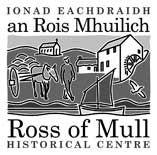Contact Us
Ross of Mull Historical CentreMillbrae Cottage
Bunessan
Isle of Mull
Argyll PA67 6DG
By Phone: 01681 700659 By Email: enquiries@romhc.org.uk
Opening Times
Our museum is open Monday to Friday
10am to 4pm

The Ross of Mull is an extraordinary microcosm of all that draws visitors to the Hebridean Islands. The scenery, as you travel along the single-track road from the ferry at Craignure is breath-taking. You experience in the many walks in the area a true sense of wilderness; the secret bays with their beaches of silvery sand, the abundance of wildlife and the innumerable marks on the landscape of the lives of past generations and communities long gone. The Ross of Mull is a compelling place for anyone fascinated by history and the ancient way of life of the Gaelic people.